Comprehensive Essay on Global Warming: Causes, Effects and Solutions
VerifiedAdded on 2023/06/10
|7
|2036
|493
Essay
AI Summary
This essay addresses the critical issue of global warming, highlighting its causes, impacts, and potential solutions. It begins by defining global warming and emphasizing the human contribution to rising temperatures. The essay then delves into specific consequences such as desertification, caused by both human activities and natural processes, leading to reduced biological productivity. The melting of glaciers, another significant impact, is discussed in terms of its effects on water supply, climate regulation, and the increasing risk of floods and water shortages. The relationship between global warming and the increasing intensity of hurricanes and cyclones is explored, noting the role of rising ocean temperatures. Finally, the essay addresses deforestation as a major contributor to global warming, emphasizing the release of carbon dioxide and the destruction of vital ecosystems. The essay concludes by advocating for human responsibility in mitigating climate change and implementing solutions to address these pressing environmental challenges; this essay and many others are available on Desklib, a website providing study tools for students.
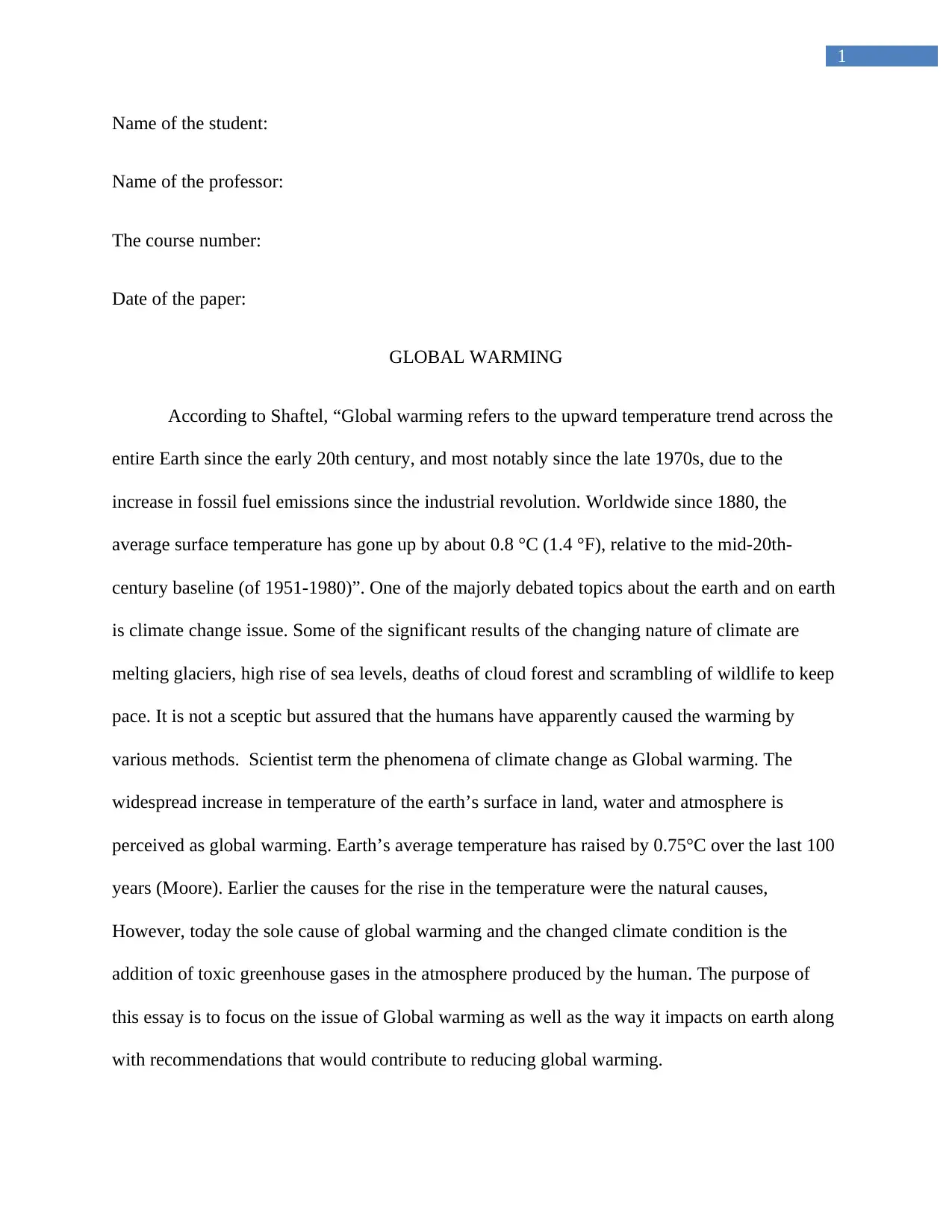
1
Name of the student:
Name of the professor:
The course number:
Date of the paper:
GLOBAL WARMING
According to Shaftel, “Global warming refers to the upward temperature trend across the
entire Earth since the early 20th century, and most notably since the late 1970s, due to the
increase in fossil fuel emissions since the industrial revolution. Worldwide since 1880, the
average surface temperature has gone up by about 0.8 °C (1.4 °F), relative to the mid-20th-
century baseline (of 1951-1980)”. One of the majorly debated topics about the earth and on earth
is climate change issue. Some of the significant results of the changing nature of climate are
melting glaciers, high rise of sea levels, deaths of cloud forest and scrambling of wildlife to keep
pace. It is not a sceptic but assured that the humans have apparently caused the warming by
various methods. Scientist term the phenomena of climate change as Global warming. The
widespread increase in temperature of the earth’s surface in land, water and atmosphere is
perceived as global warming. Earth’s average temperature has raised by 0.75°C over the last 100
years (Moore). Earlier the causes for the rise in the temperature were the natural causes,
However, today the sole cause of global warming and the changed climate condition is the
addition of toxic greenhouse gases in the atmosphere produced by the human. The purpose of
this essay is to focus on the issue of Global warming as well as the way it impacts on earth along
with recommendations that would contribute to reducing global warming.
Name of the student:
Name of the professor:
The course number:
Date of the paper:
GLOBAL WARMING
According to Shaftel, “Global warming refers to the upward temperature trend across the
entire Earth since the early 20th century, and most notably since the late 1970s, due to the
increase in fossil fuel emissions since the industrial revolution. Worldwide since 1880, the
average surface temperature has gone up by about 0.8 °C (1.4 °F), relative to the mid-20th-
century baseline (of 1951-1980)”. One of the majorly debated topics about the earth and on earth
is climate change issue. Some of the significant results of the changing nature of climate are
melting glaciers, high rise of sea levels, deaths of cloud forest and scrambling of wildlife to keep
pace. It is not a sceptic but assured that the humans have apparently caused the warming by
various methods. Scientist term the phenomena of climate change as Global warming. The
widespread increase in temperature of the earth’s surface in land, water and atmosphere is
perceived as global warming. Earth’s average temperature has raised by 0.75°C over the last 100
years (Moore). Earlier the causes for the rise in the temperature were the natural causes,
However, today the sole cause of global warming and the changed climate condition is the
addition of toxic greenhouse gases in the atmosphere produced by the human. The purpose of
this essay is to focus on the issue of Global warming as well as the way it impacts on earth along
with recommendations that would contribute to reducing global warming.
Paraphrase This Document
Need a fresh take? Get an instant paraphrase of this document with our AI Paraphraser
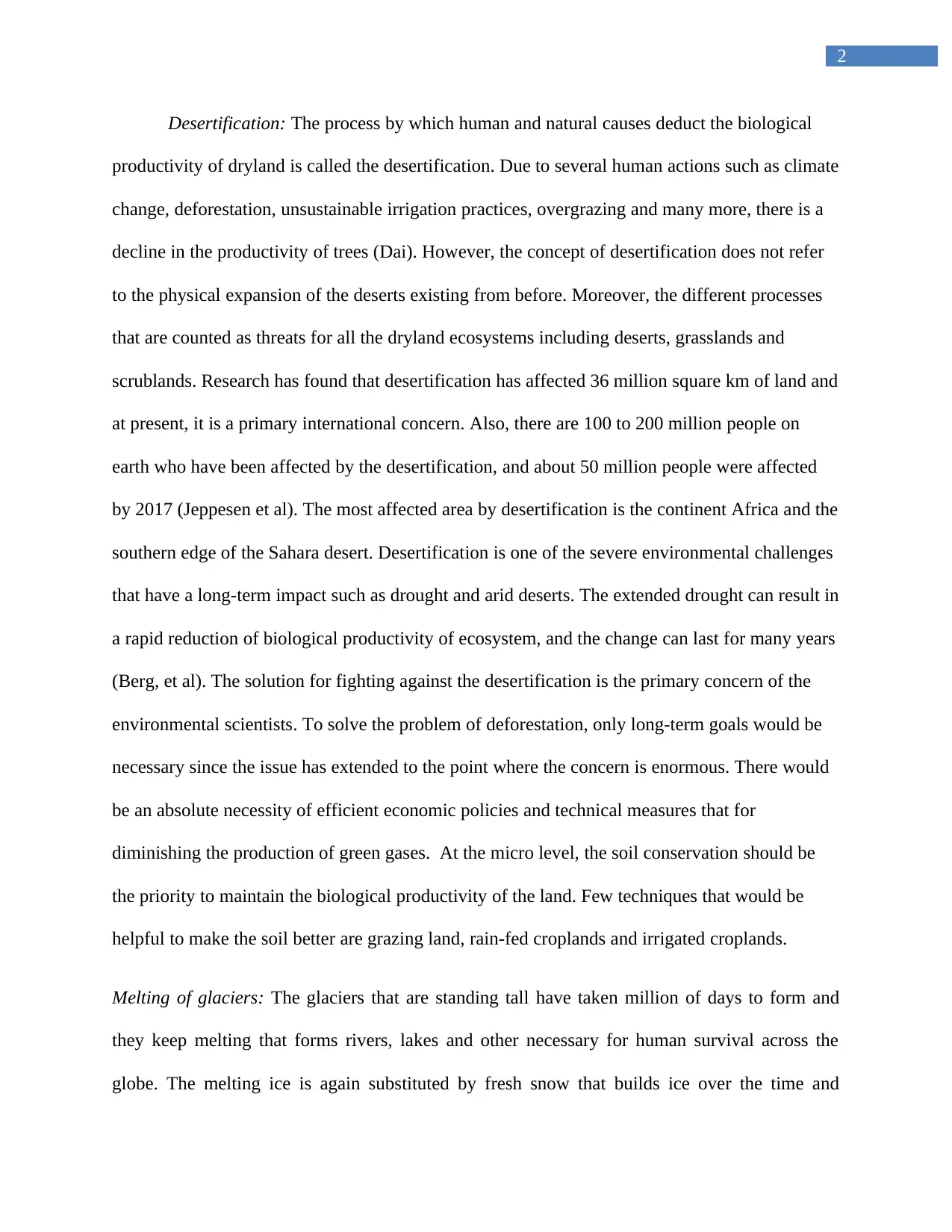
2
Desertification: The process by which human and natural causes deduct the biological
productivity of dryland is called the desertification. Due to several human actions such as climate
change, deforestation, unsustainable irrigation practices, overgrazing and many more, there is a
decline in the productivity of trees (Dai). However, the concept of desertification does not refer
to the physical expansion of the deserts existing from before. Moreover, the different processes
that are counted as threats for all the dryland ecosystems including deserts, grasslands and
scrublands. Research has found that desertification has affected 36 million square km of land and
at present, it is a primary international concern. Also, there are 100 to 200 million people on
earth who have been affected by the desertification, and about 50 million people were affected
by 2017 (Jeppesen et al). The most affected area by desertification is the continent Africa and the
southern edge of the Sahara desert. Desertification is one of the severe environmental challenges
that have a long-term impact such as drought and arid deserts. The extended drought can result in
a rapid reduction of biological productivity of ecosystem, and the change can last for many years
(Berg, et al). The solution for fighting against the desertification is the primary concern of the
environmental scientists. To solve the problem of deforestation, only long-term goals would be
necessary since the issue has extended to the point where the concern is enormous. There would
be an absolute necessity of efficient economic policies and technical measures that for
diminishing the production of green gases. At the micro level, the soil conservation should be
the priority to maintain the biological productivity of the land. Few techniques that would be
helpful to make the soil better are grazing land, rain-fed croplands and irrigated croplands.
Melting of glaciers: The glaciers that are standing tall have taken million of days to form and
they keep melting that forms rivers, lakes and other necessary for human survival across the
globe. The melting ice is again substituted by fresh snow that builds ice over the time and
Desertification: The process by which human and natural causes deduct the biological
productivity of dryland is called the desertification. Due to several human actions such as climate
change, deforestation, unsustainable irrigation practices, overgrazing and many more, there is a
decline in the productivity of trees (Dai). However, the concept of desertification does not refer
to the physical expansion of the deserts existing from before. Moreover, the different processes
that are counted as threats for all the dryland ecosystems including deserts, grasslands and
scrublands. Research has found that desertification has affected 36 million square km of land and
at present, it is a primary international concern. Also, there are 100 to 200 million people on
earth who have been affected by the desertification, and about 50 million people were affected
by 2017 (Jeppesen et al). The most affected area by desertification is the continent Africa and the
southern edge of the Sahara desert. Desertification is one of the severe environmental challenges
that have a long-term impact such as drought and arid deserts. The extended drought can result in
a rapid reduction of biological productivity of ecosystem, and the change can last for many years
(Berg, et al). The solution for fighting against the desertification is the primary concern of the
environmental scientists. To solve the problem of deforestation, only long-term goals would be
necessary since the issue has extended to the point where the concern is enormous. There would
be an absolute necessity of efficient economic policies and technical measures that for
diminishing the production of green gases. At the micro level, the soil conservation should be
the priority to maintain the biological productivity of the land. Few techniques that would be
helpful to make the soil better are grazing land, rain-fed croplands and irrigated croplands.
Melting of glaciers: The glaciers that are standing tall have taken million of days to form and
they keep melting that forms rivers, lakes and other necessary for human survival across the
globe. The melting ice is again substituted by fresh snow that builds ice over the time and
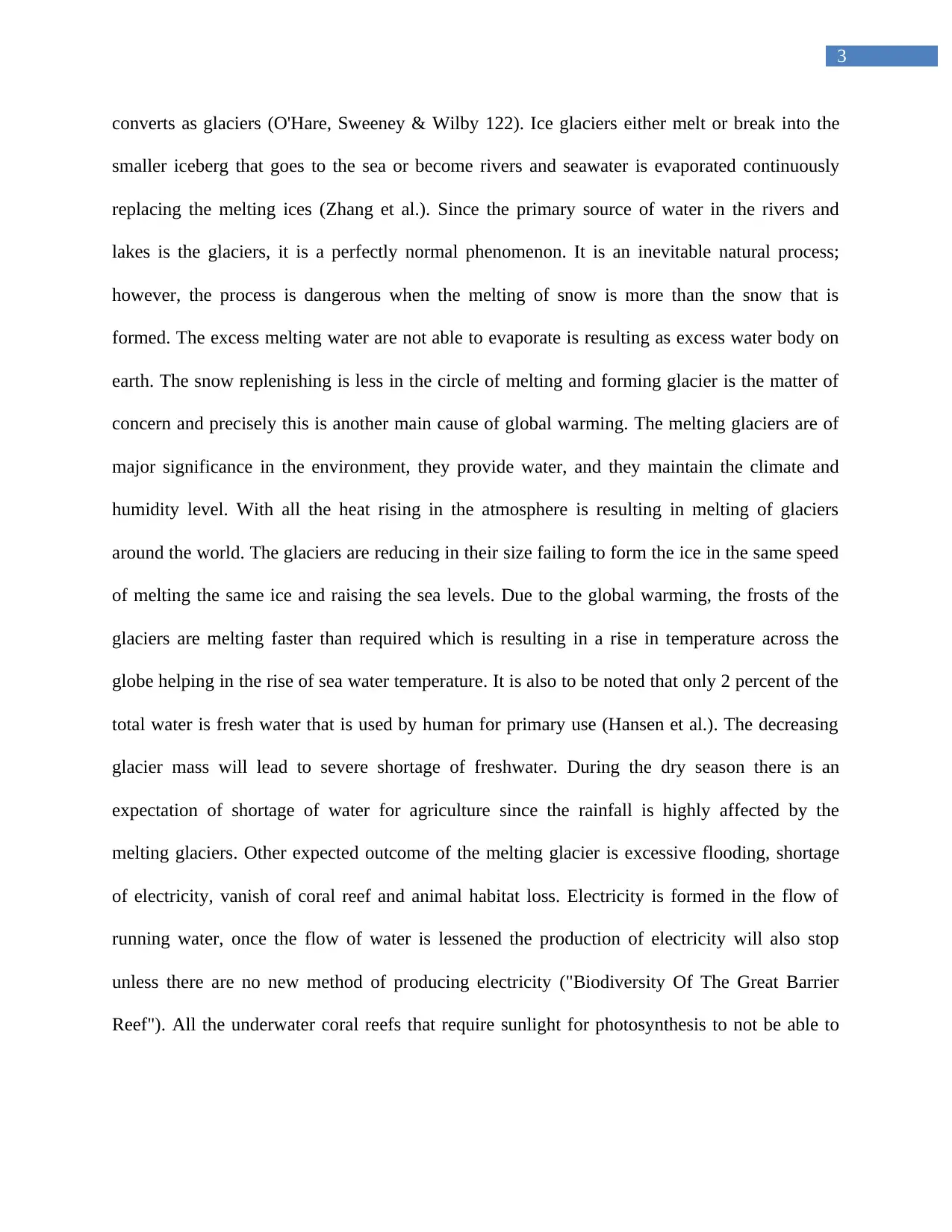
3
converts as glaciers (O'Hare, Sweeney & Wilby 122). Ice glaciers either melt or break into the
smaller iceberg that goes to the sea or become rivers and seawater is evaporated continuously
replacing the melting ices (Zhang et al.). Since the primary source of water in the rivers and
lakes is the glaciers, it is a perfectly normal phenomenon. It is an inevitable natural process;
however, the process is dangerous when the melting of snow is more than the snow that is
formed. The excess melting water are not able to evaporate is resulting as excess water body on
earth. The snow replenishing is less in the circle of melting and forming glacier is the matter of
concern and precisely this is another main cause of global warming. The melting glaciers are of
major significance in the environment, they provide water, and they maintain the climate and
humidity level. With all the heat rising in the atmosphere is resulting in melting of glaciers
around the world. The glaciers are reducing in their size failing to form the ice in the same speed
of melting the same ice and raising the sea levels. Due to the global warming, the frosts of the
glaciers are melting faster than required which is resulting in a rise in temperature across the
globe helping in the rise of sea water temperature. It is also to be noted that only 2 percent of the
total water is fresh water that is used by human for primary use (Hansen et al.). The decreasing
glacier mass will lead to severe shortage of freshwater. During the dry season there is an
expectation of shortage of water for agriculture since the rainfall is highly affected by the
melting glaciers. Other expected outcome of the melting glacier is excessive flooding, shortage
of electricity, vanish of coral reef and animal habitat loss. Electricity is formed in the flow of
running water, once the flow of water is lessened the production of electricity will also stop
unless there are no new method of producing electricity ("Biodiversity Of The Great Barrier
Reef"). All the underwater coral reefs that require sunlight for photosynthesis to not be able to
converts as glaciers (O'Hare, Sweeney & Wilby 122). Ice glaciers either melt or break into the
smaller iceberg that goes to the sea or become rivers and seawater is evaporated continuously
replacing the melting ices (Zhang et al.). Since the primary source of water in the rivers and
lakes is the glaciers, it is a perfectly normal phenomenon. It is an inevitable natural process;
however, the process is dangerous when the melting of snow is more than the snow that is
formed. The excess melting water are not able to evaporate is resulting as excess water body on
earth. The snow replenishing is less in the circle of melting and forming glacier is the matter of
concern and precisely this is another main cause of global warming. The melting glaciers are of
major significance in the environment, they provide water, and they maintain the climate and
humidity level. With all the heat rising in the atmosphere is resulting in melting of glaciers
around the world. The glaciers are reducing in their size failing to form the ice in the same speed
of melting the same ice and raising the sea levels. Due to the global warming, the frosts of the
glaciers are melting faster than required which is resulting in a rise in temperature across the
globe helping in the rise of sea water temperature. It is also to be noted that only 2 percent of the
total water is fresh water that is used by human for primary use (Hansen et al.). The decreasing
glacier mass will lead to severe shortage of freshwater. During the dry season there is an
expectation of shortage of water for agriculture since the rainfall is highly affected by the
melting glaciers. Other expected outcome of the melting glacier is excessive flooding, shortage
of electricity, vanish of coral reef and animal habitat loss. Electricity is formed in the flow of
running water, once the flow of water is lessened the production of electricity will also stop
unless there are no new method of producing electricity ("Biodiversity Of The Great Barrier
Reef"). All the underwater coral reefs that require sunlight for photosynthesis to not be able to
⊘ This is a preview!⊘
Do you want full access?
Subscribe today to unlock all pages.

Trusted by 1+ million students worldwide
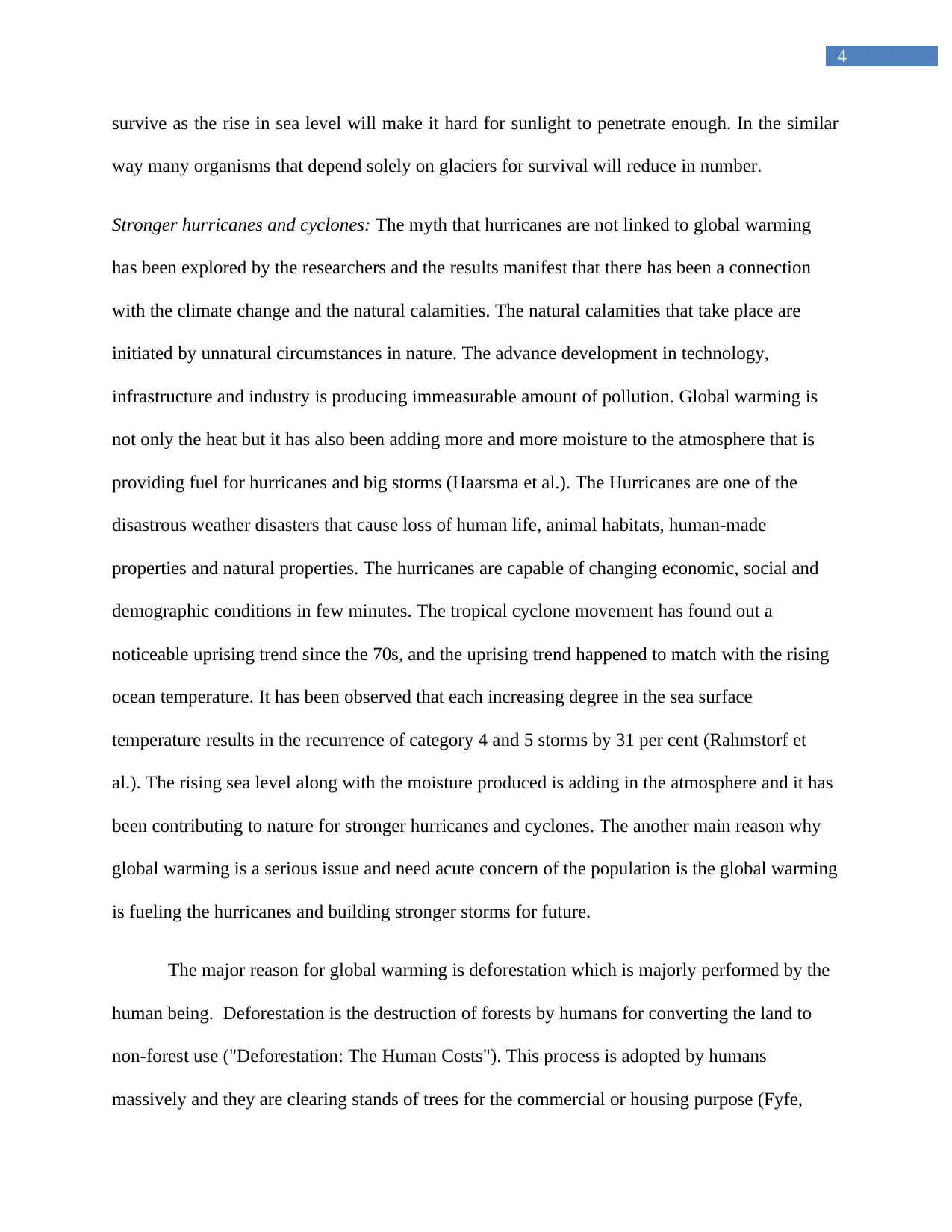
4
survive as the rise in sea level will make it hard for sunlight to penetrate enough. In the similar
way many organisms that depend solely on glaciers for survival will reduce in number.
Stronger hurricanes and cyclones: The myth that hurricanes are not linked to global warming
has been explored by the researchers and the results manifest that there has been a connection
with the climate change and the natural calamities. The natural calamities that take place are
initiated by unnatural circumstances in nature. The advance development in technology,
infrastructure and industry is producing immeasurable amount of pollution. Global warming is
not only the heat but it has also been adding more and more moisture to the atmosphere that is
providing fuel for hurricanes and big storms (Haarsma et al.). The Hurricanes are one of the
disastrous weather disasters that cause loss of human life, animal habitats, human-made
properties and natural properties. The hurricanes are capable of changing economic, social and
demographic conditions in few minutes. The tropical cyclone movement has found out a
noticeable uprising trend since the 70s, and the uprising trend happened to match with the rising
ocean temperature. It has been observed that each increasing degree in the sea surface
temperature results in the recurrence of category 4 and 5 storms by 31 per cent (Rahmstorf et
al.). The rising sea level along with the moisture produced is adding in the atmosphere and it has
been contributing to nature for stronger hurricanes and cyclones. The another main reason why
global warming is a serious issue and need acute concern of the population is the global warming
is fueling the hurricanes and building stronger storms for future.
The major reason for global warming is deforestation which is majorly performed by the
human being. Deforestation is the destruction of forests by humans for converting the land to
non-forest use ("Deforestation: The Human Costs"). This process is adopted by humans
massively and they are clearing stands of trees for the commercial or housing purpose (Fyfe,
survive as the rise in sea level will make it hard for sunlight to penetrate enough. In the similar
way many organisms that depend solely on glaciers for survival will reduce in number.
Stronger hurricanes and cyclones: The myth that hurricanes are not linked to global warming
has been explored by the researchers and the results manifest that there has been a connection
with the climate change and the natural calamities. The natural calamities that take place are
initiated by unnatural circumstances in nature. The advance development in technology,
infrastructure and industry is producing immeasurable amount of pollution. Global warming is
not only the heat but it has also been adding more and more moisture to the atmosphere that is
providing fuel for hurricanes and big storms (Haarsma et al.). The Hurricanes are one of the
disastrous weather disasters that cause loss of human life, animal habitats, human-made
properties and natural properties. The hurricanes are capable of changing economic, social and
demographic conditions in few minutes. The tropical cyclone movement has found out a
noticeable uprising trend since the 70s, and the uprising trend happened to match with the rising
ocean temperature. It has been observed that each increasing degree in the sea surface
temperature results in the recurrence of category 4 and 5 storms by 31 per cent (Rahmstorf et
al.). The rising sea level along with the moisture produced is adding in the atmosphere and it has
been contributing to nature for stronger hurricanes and cyclones. The another main reason why
global warming is a serious issue and need acute concern of the population is the global warming
is fueling the hurricanes and building stronger storms for future.
The major reason for global warming is deforestation which is majorly performed by the
human being. Deforestation is the destruction of forests by humans for converting the land to
non-forest use ("Deforestation: The Human Costs"). This process is adopted by humans
massively and they are clearing stands of trees for the commercial or housing purpose (Fyfe,
Paraphrase This Document
Need a fresh take? Get an instant paraphrase of this document with our AI Paraphraser
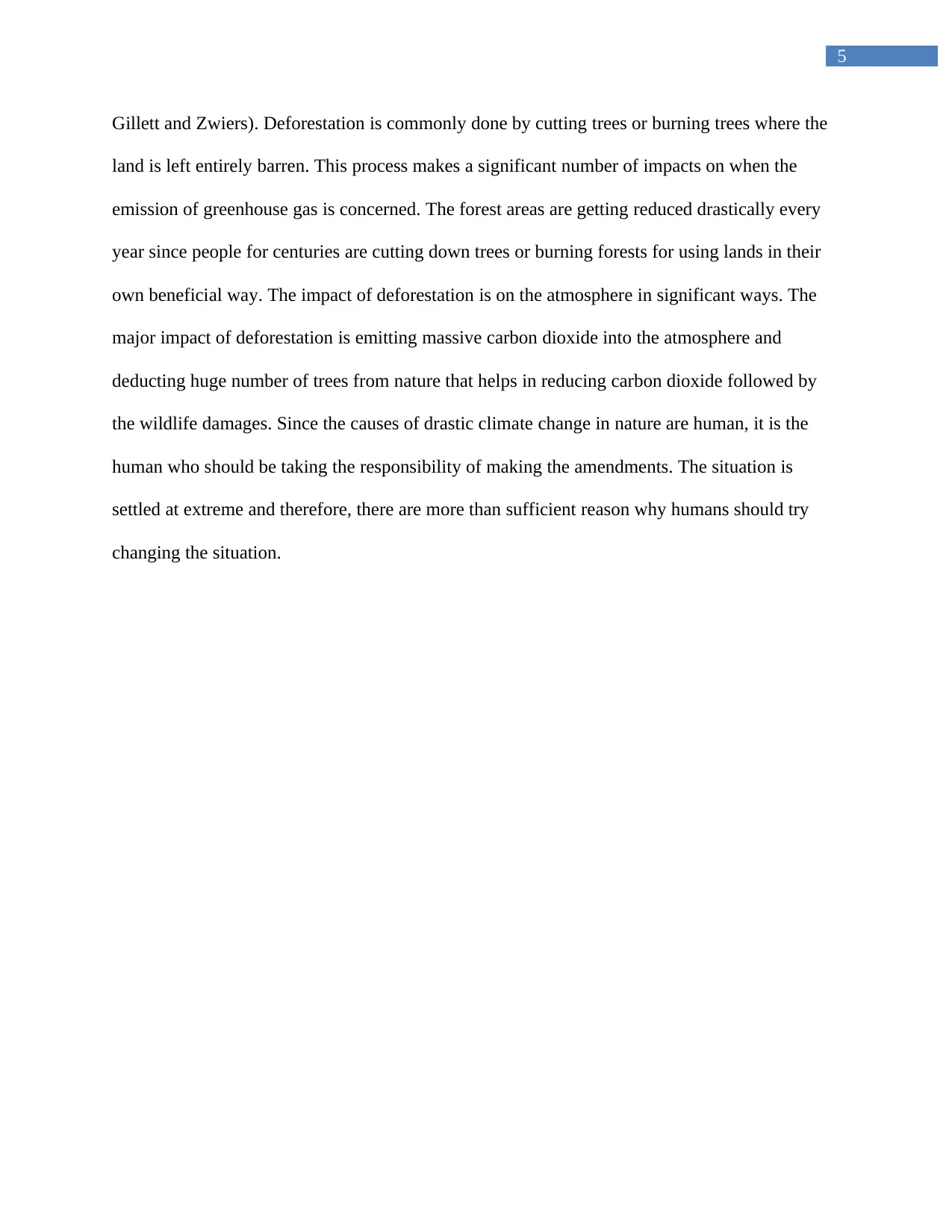
5
Gillett and Zwiers). Deforestation is commonly done by cutting trees or burning trees where the
land is left entirely barren. This process makes a significant number of impacts on when the
emission of greenhouse gas is concerned. The forest areas are getting reduced drastically every
year since people for centuries are cutting down trees or burning forests for using lands in their
own beneficial way. The impact of deforestation is on the atmosphere in significant ways. The
major impact of deforestation is emitting massive carbon dioxide into the atmosphere and
deducting huge number of trees from nature that helps in reducing carbon dioxide followed by
the wildlife damages. Since the causes of drastic climate change in nature are human, it is the
human who should be taking the responsibility of making the amendments. The situation is
settled at extreme and therefore, there are more than sufficient reason why humans should try
changing the situation.
Gillett and Zwiers). Deforestation is commonly done by cutting trees or burning trees where the
land is left entirely barren. This process makes a significant number of impacts on when the
emission of greenhouse gas is concerned. The forest areas are getting reduced drastically every
year since people for centuries are cutting down trees or burning forests for using lands in their
own beneficial way. The impact of deforestation is on the atmosphere in significant ways. The
major impact of deforestation is emitting massive carbon dioxide into the atmosphere and
deducting huge number of trees from nature that helps in reducing carbon dioxide followed by
the wildlife damages. Since the causes of drastic climate change in nature are human, it is the
human who should be taking the responsibility of making the amendments. The situation is
settled at extreme and therefore, there are more than sufficient reason why humans should try
changing the situation.
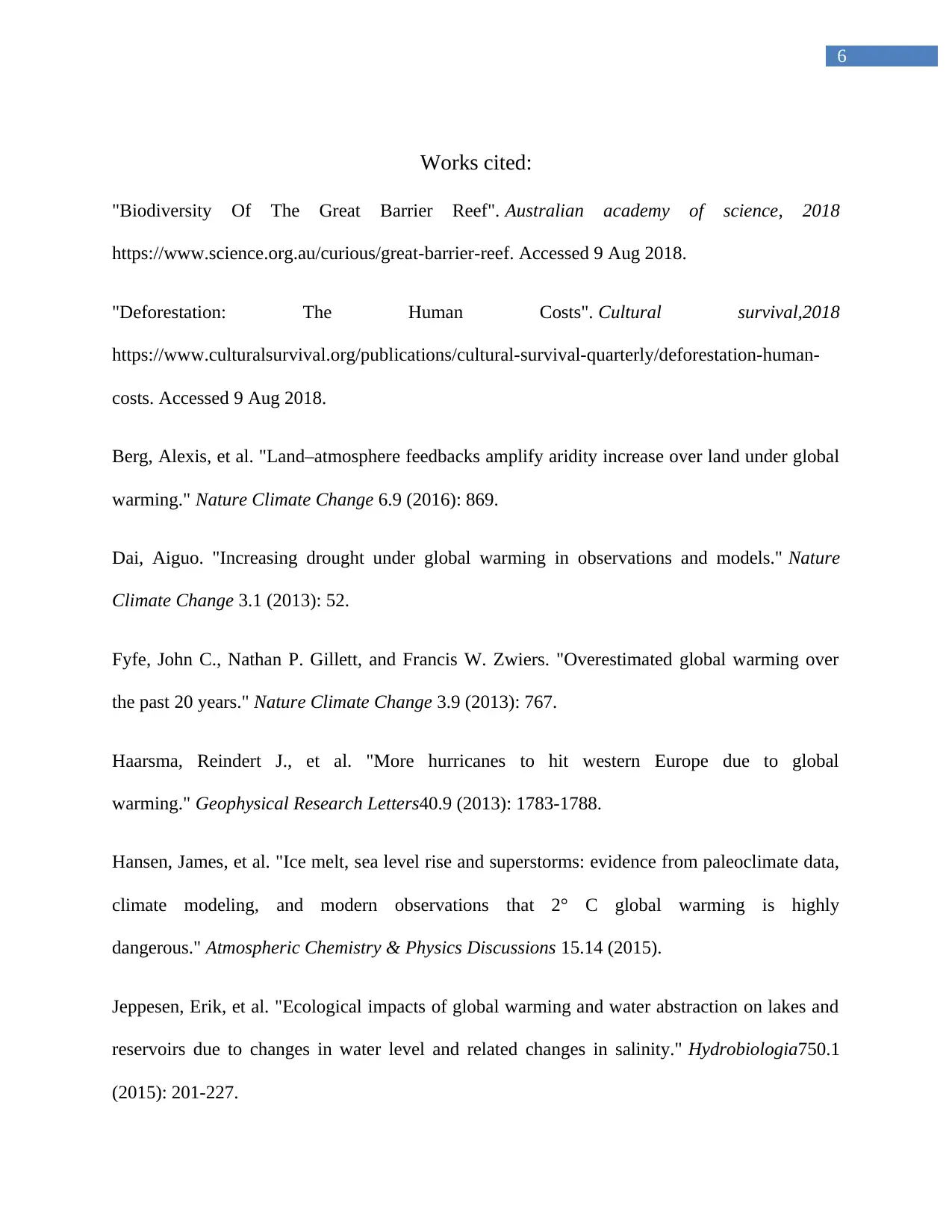
6
Works cited:
"Biodiversity Of The Great Barrier Reef". Australian academy of science, 2018
https://www.science.org.au/curious/great-barrier-reef. Accessed 9 Aug 2018.
"Deforestation: The Human Costs". Cultural survival,2018
https://www.culturalsurvival.org/publications/cultural-survival-quarterly/deforestation-human-
costs. Accessed 9 Aug 2018.
Berg, Alexis, et al. "Land–atmosphere feedbacks amplify aridity increase over land under global
warming." Nature Climate Change 6.9 (2016): 869.
Dai, Aiguo. "Increasing drought under global warming in observations and models." Nature
Climate Change 3.1 (2013): 52.
Fyfe, John C., Nathan P. Gillett, and Francis W. Zwiers. "Overestimated global warming over
the past 20 years." Nature Climate Change 3.9 (2013): 767.
Haarsma, Reindert J., et al. "More hurricanes to hit western Europe due to global
warming." Geophysical Research Letters40.9 (2013): 1783-1788.
Hansen, James, et al. "Ice melt, sea level rise and superstorms: evidence from paleoclimate data,
climate modeling, and modern observations that 2° C global warming is highly
dangerous." Atmospheric Chemistry & Physics Discussions 15.14 (2015).
Jeppesen, Erik, et al. "Ecological impacts of global warming and water abstraction on lakes and
reservoirs due to changes in water level and related changes in salinity." Hydrobiologia750.1
(2015): 201-227.
Works cited:
"Biodiversity Of The Great Barrier Reef". Australian academy of science, 2018
https://www.science.org.au/curious/great-barrier-reef. Accessed 9 Aug 2018.
"Deforestation: The Human Costs". Cultural survival,2018
https://www.culturalsurvival.org/publications/cultural-survival-quarterly/deforestation-human-
costs. Accessed 9 Aug 2018.
Berg, Alexis, et al. "Land–atmosphere feedbacks amplify aridity increase over land under global
warming." Nature Climate Change 6.9 (2016): 869.
Dai, Aiguo. "Increasing drought under global warming in observations and models." Nature
Climate Change 3.1 (2013): 52.
Fyfe, John C., Nathan P. Gillett, and Francis W. Zwiers. "Overestimated global warming over
the past 20 years." Nature Climate Change 3.9 (2013): 767.
Haarsma, Reindert J., et al. "More hurricanes to hit western Europe due to global
warming." Geophysical Research Letters40.9 (2013): 1783-1788.
Hansen, James, et al. "Ice melt, sea level rise and superstorms: evidence from paleoclimate data,
climate modeling, and modern observations that 2° C global warming is highly
dangerous." Atmospheric Chemistry & Physics Discussions 15.14 (2015).
Jeppesen, Erik, et al. "Ecological impacts of global warming and water abstraction on lakes and
reservoirs due to changes in water level and related changes in salinity." Hydrobiologia750.1
(2015): 201-227.
⊘ This is a preview!⊘
Do you want full access?
Subscribe today to unlock all pages.

Trusted by 1+ million students worldwide
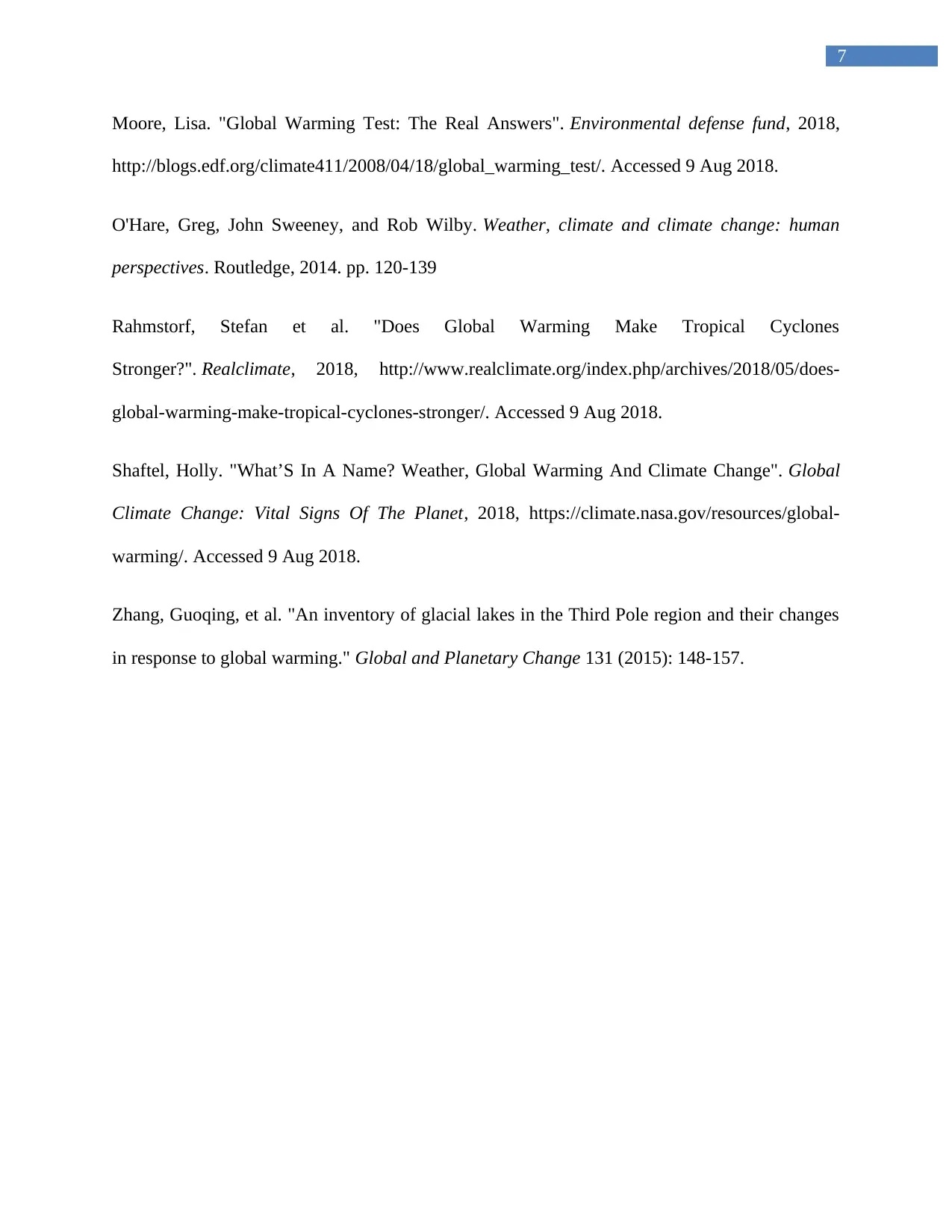
7
Moore, Lisa. "Global Warming Test: The Real Answers". Environmental defense fund, 2018,
http://blogs.edf.org/climate411/2008/04/18/global_warming_test/. Accessed 9 Aug 2018.
O'Hare, Greg, John Sweeney, and Rob Wilby. Weather, climate and climate change: human
perspectives. Routledge, 2014. pp. 120-139
Rahmstorf, Stefan et al. "Does Global Warming Make Tropical Cyclones
Stronger?". Realclimate, 2018, http://www.realclimate.org/index.php/archives/2018/05/does-
global-warming-make-tropical-cyclones-stronger/. Accessed 9 Aug 2018.
Shaftel, Holly. "What’S In A Name? Weather, Global Warming And Climate Change". Global
Climate Change: Vital Signs Of The Planet, 2018, https://climate.nasa.gov/resources/global-
warming/. Accessed 9 Aug 2018.
Zhang, Guoqing, et al. "An inventory of glacial lakes in the Third Pole region and their changes
in response to global warming." Global and Planetary Change 131 (2015): 148-157.
Moore, Lisa. "Global Warming Test: The Real Answers". Environmental defense fund, 2018,
http://blogs.edf.org/climate411/2008/04/18/global_warming_test/. Accessed 9 Aug 2018.
O'Hare, Greg, John Sweeney, and Rob Wilby. Weather, climate and climate change: human
perspectives. Routledge, 2014. pp. 120-139
Rahmstorf, Stefan et al. "Does Global Warming Make Tropical Cyclones
Stronger?". Realclimate, 2018, http://www.realclimate.org/index.php/archives/2018/05/does-
global-warming-make-tropical-cyclones-stronger/. Accessed 9 Aug 2018.
Shaftel, Holly. "What’S In A Name? Weather, Global Warming And Climate Change". Global
Climate Change: Vital Signs Of The Planet, 2018, https://climate.nasa.gov/resources/global-
warming/. Accessed 9 Aug 2018.
Zhang, Guoqing, et al. "An inventory of glacial lakes in the Third Pole region and their changes
in response to global warming." Global and Planetary Change 131 (2015): 148-157.
1 out of 7
Related Documents
Your All-in-One AI-Powered Toolkit for Academic Success.
+13062052269
info@desklib.com
Available 24*7 on WhatsApp / Email
![[object Object]](/_next/static/media/star-bottom.7253800d.svg)
Unlock your academic potential
Copyright © 2020–2025 A2Z Services. All Rights Reserved. Developed and managed by ZUCOL.





